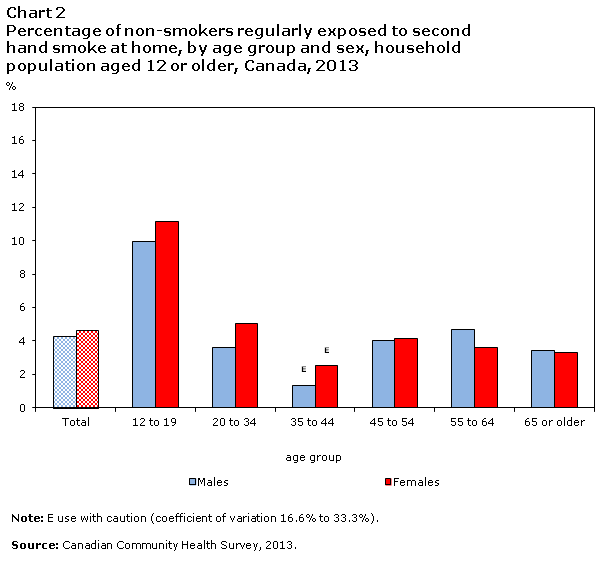Exposure to second-hand smoke at home, 2013
Archived Content
Information identified as archived is provided for reference, research or recordkeeping purposes. It is not subject to the Government of Canada Web Standards and has not been altered or updated since it was archived. Please "contact us" to request a format other than those available.

‘Passive smoking,’ or exposure to second-hand smoke, has negative respiratory health effects. Two of the most common diseases associated with breathing in second-hand smoke are lung cancer in adults and asthma among children.
The proportion of non-smokers aged 12 and older who were regularly exposed to second-hand smoke at home was 4.5% in 2013, around the same as 2012. This rate has declined significantly since 2003 when it was 10.6%. The rate of exposure to second hand smoke at home was the same for both males and females in 2013 (Chart 1).
In 2013, 10.5% of young Canadians aged 12 to 19 were exposed to second-hand smoke at home—a decrease from 23.4% in 2003 (Chart 1). This age group is the most likely to be exposed to second hand smoke at home. Of the 1.1 million non-smoking Canadians aged 12+ who were regularly exposed to second-hand smoke at home, the 12 to 19 age group made up 28.3%.

Females aged 20 to 34 were significantly more likely than males to be exposed to second-hand smoke at homeNote 1; however, there was no significant difference between the sexes in other age groups (Chart 2).

The proportion of residents who reported exposure to second-hand smoke at home was lower than the national average (4.5%) in:
- Ontario (3.9%)
- British Columbia (2.2%)
The proportion of residents who reported exposure to second-hand smoke at home was higher than the national average in:
- Nova Scotia (8.1%)
- Quebec (6.7%)
Residents of the other provincesNote 2 and territoriesNote 2 had rates that were about the same as the national average.
End notes
References
Shields, Margot. 2007. “Smoking—prevalence, bans and exposure to second-hand smoke.” Health Reports, 18(3): 67–85. http://www.statcan.gc.ca/pub/82-003-x/2006007/article/smoking-fumer/10198-eng.pdf (accessed June 3, 2010)
Pérez, Claudio E. 2004. “Second-hand smoke exposure—who's at risk.” Health Reports, 16(1): 9–17. http://www.statcan.gc.ca/studies-etudes/82-003/archive/2004/7037-eng.pdf (accessed June 3, 2010)
Bearer C. 1995. “Environmental health hazards: how children are different from adults.” The Future of Children:Critical Issues for Children and Youths. Vol. 5. no. 2. pp11-26. http://www.jstor.org/stable/1602354 (accessed May 15, 2013).
Data
Additional data from the Canadian Community Health Survey are available from CANSIM table 105–0501.
- Date modified:
